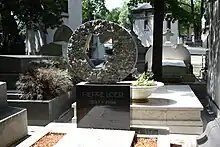Pierre Loeb
Pierre Loeb (born September 24, 1897, in Paris; died May 4, 1964)[1] was a French art dealer and gallery owner who focused primarily on Surrealism and 20th-century Modernism. In 1924 he founded the Galerie Pierre in Paris,[2] whose most famous exhibition was the first collective exhibition of Surrealists the following year.
Life
Pierre Loeb worked in his father's rope-making business. He met the dentist Daniel Tzanck, an art collector who introduced him to modern art. Tsanck was friends with the Bulgarian painter Jules Pascin as well as the French painter André Derain.[3] In 1924, Loeb opened his Galerie Pierre at 13 rue Bonaparte in Paris and presented Pascin's works in his first exhibition.[4] In the gallery's most famous exhibition, La peinture surréaliste (November 14–26, 1925), the first group exhibition of Surrealist painters, Loeb presented works by Hans Arp, Paul Klee, Man Ray, Max Ernst, Pablo Picasso, Joan Miró, Giorgio de Chirico, as well as André Masson
.

In 1926, he moved the gallery to house number 2, also on Rue Bonaparte. In the same year Loeb met for the first time in person with Pablo Picasso, with whom he later became good friends and whose works he exhibited in 1929. He was also a great follower of Joan Miró, whose works he exhibited eleven times from 1927 to 1939.[5] In 1930 Loeb showed sculptures by Henri Matisse, in 1934 the gallery hosted the first exhibition of the artist Balthus and in 1936 the first solo exhibition of Wolfgang Paalen. In 1938 he focused on the landscape paintings of Georges Braque.
Nazi persecution and exile

When the Nazis occupied Paris in 1940, Loeb was persecuted because of his Jewish heritage. His art gallery was Aryanized, that is, transferred to a non-Jewish owner, Georges Aubry, in 1941.[6] In 1942 he fled to Cuba, where he lived until the end of the war.
Postwar
After the end of the war, Loeb returned to Paris and recovered his gallery, though not without difficulty.[6][1] He organized a sensational exhibition of drawings by Antonin Artaud (1947). After that, he focused with great energy on abstract painting, exhibiting works by the artist group CoBrA and the École de Paris, as well as by individual artists such as Maria Helena Vieira da Silva, Zao Wou-Ki, and Camille Bryen.
In 1957 he married Agathe Vaito.[7]
In 1964 Pierre Loeb died one of the most famous art dealers and gallery owners of modernism. He rests in the Cimetière Montparnasse (28th Division).[8] The grave is adorned with a granite sculpture entitled La Roue (The Wheel) by Hans Arp from 1965.
Family
Pierre Loeb was the brother of photographer Denise Colomb (1902-2004). His son Albert Loeb (b. 1932) owned a gallery in New York City from 1958 to 1971[9][10] and opened a gallery in 1966 until February 2015 existing gallery in Paris.[11] Pierre Loeb's grandchildren are the chanson singer, actress and director Caroline Loeb (* 1955) and the actor Martin Loeb (* 1959).
External links
- Isabelle Monod-Fontaine: Loeb, Pierre. Grove Art Online. Oxford University Press; http://www.groveart.com/ (Anmeldung erforderlich)
References
- "Pierre Loeb kb984". 2014-10-08. Archived from the original on 2014-10-08. Retrieved 2022-02-10.
- "Galerie Pierre". www.nga.gov. Retrieved 2022-02-10.
- "Loeb, Pierre Paris, 1897–Paris, 1964". www.metmuseum.org. Retrieved 2022-02-10.
- Schneider, Pierre (1979-07-11). "Paris Museum Salutes a Dealer". The New York Times. ISSN 0362-4331. Retrieved 2022-02-16.
- Vogel, Carol (2004-09-17). "Next Up at City Hall". The New York Times. ISSN 0362-4331. Archived from the original on 2022-02-16. Retrieved 2022-02-16.
Halpern, who died in April, started collecting toward the end of World War II when he was based in London and Paris as a naval officer. On a trip to Paris, he talked Miró's dealer, Pierre Loeb, into accepting his overcoat in exchange for "Caress of the Stars," a 1938 Miró painting. When the war ended, Halpern returned to New York in a military plane with the painting wrapped in a blanket on his lap.
- "Le marché de l'art sous l'Occupation (1940-1944)". Expo Marché Art. Retrieved 2022-02-10.
- Musée d'art moderne de la ville de Paris; Musée d'Ixelles (1979). L'Aventure de Pierre Loeb, la Galerie Pierre, Paris, 1924-1964 : Musée d'art moderne de la Ville de Paris, du 7 juin au 16 septembre 1979, Musée d'Ixelles, Bruxelles, du 4 octobre au 23 décembre 1979 (in French). Paris: Musée d'art moderne de la Ville de Paris. OCLC 643669826.
- "Pierre Loeb kb984". 2014-10-08. Archived from the original on 2014-10-08. Retrieved 2022-02-10.
Één van de laatste tentoonstellingen, n.l. van 22 maart t/m 8 april 1963, was gewijd aan werk van zijn vrouw Agathe. Pierre Loeb, die in 1963 de galerie sloot, overleed op 4 mei 1964 en werd begraven op de Cimetière du Montparnasse.
- Times, Hilton Kramer Special to The New York (1972-06-27). "3 ‐ Year‐Old Basel Art Fair Lures Some Top Dealers". The New York Times. ISSN 0362-4331. Retrieved 2022-02-10.
- Ashton, Dore (1959-05-22). "Art: Dutch Landscapes; Constantin Macris' Work at Loeb Gallery -- Vander Sluis Has First Show Here". The New York Times. ISSN 0362-4331. Retrieved 2022-02-10.
- "La galerie Albert Loeb ferme". Le Journal Des Arts (in French). Archived from the original on 2019-05-07. Retrieved 2022-02-16.